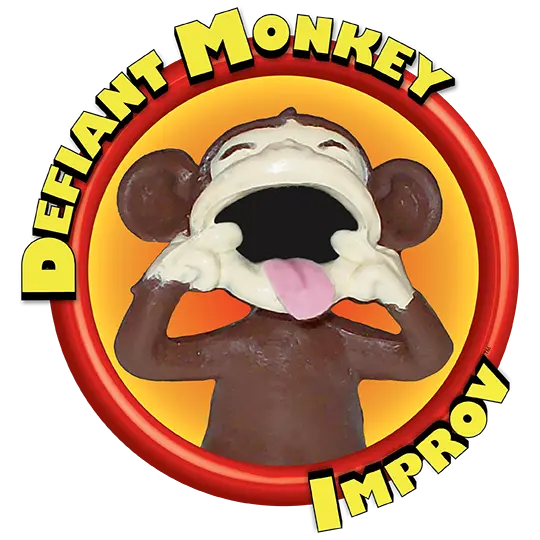How to figure out the “What” of improv.

If you’re looking for a book to help you learn the “How” of improv, there are dozens of them out there. If you are, instead, looking for the “What” of improv, you’ll be hard pressed to find anything of any depth, at least anything specifically designed for improvisation.
Let’s take our first foray into the “What.” We will start out by explaining what the “What” isn’t: the “What” isn’t the rules of improv; it’s not telling you the mechanisms behind good improv. Instead, it focuses on the substance of what you’re creating, the “stuff” of good improv.
If the “How” tells you how to nail boards together, the “What” helps you design your Dream Home. It gives you the knowledge to know how many bathrooms you want, where you want the bedrooms, and whether you want a crawlspace or a finished basement.
Here is your first Guideline of What:
Never mistake activity for story.

Too often we’ve witnessed improv actors stroll out onto stage after receiving a suggestion like, “shoes,” and begin a scene where someone is shopping for shoes. “Do you have this in black?” one actor asks.
Will their scene partner move the story forward by having some strange flashback involving black sneakers?
Will they pique our interest by saying, sotto voce, “My wife loved black shoes…”
Will they surreptitiously pass their fellow actor a note, saying, “The owl hoots at midnight?”
No.
They will say, “I’ll check,” rummage around a bit, and come back either saying “Yes we do,” or “No we don’t.”
Activity, not story.
“Doing something” is not enough; while it is a starting point, it must be used to launch us into story. We are here to be interesting, not funny (the funny will come from the interesting.) Shopping for shoes in and of itself is not interesting; we must make it so by building story. The only way we can do that is by letting go of our fear and journeying into the unknown. What do we mean by that? Let’s dissect it:
When we enter into an activity, we are doing something for the sake of doing it. Again, someone walking into a shoe store is not in and of itself a bad thing. Where we go after that initial offer is what counts.
When we are fearful of the unknown, we fall back on the familiar,
clutching it like a time-worn teddy bear to our bosom. We go shopping, we go to the doctor’s, we have arguments that go nowhere, we sit in our imaginary living room, refusing to go out to the club in our shiny new outfit. We become mundane. Mundane is not interesting. Mundane is the death of improv.
What is interesting is the “tilt;” when we take the mundane and twist its nipples until they hurt. This doesn’t mean we have to go to the absurd, although that can be a valid option. We simply have to chuck our fear and take that leap of faith, like Indiana Jones while seeking the Grail. When we move past our fear and boldly go where no improviser has gone before (two nerd references in one paragraph – Score!) we then begin to craft a story.
Story is the narrative. It’s the tale we tell that pulls the audience in and wraps them around our little fingers. It starts with a kernel and builds through struggle and conflict until it reaches a climax, providing the release (to varying degrees depending on the length of the scene and the handle being employed). That’s where the laughter comes from. Cheap laughter comes from the joke. We leave it to the stand-up comics to do that; we craft laughter from the telling of stories.
Laughter is the result of tension and release. If you’ve ever watched a horror movie with a group of people you have seen the mechanism at work: tension is created when we see a character walking backwards through the dark woods, then when they bump into something and scream we laugh when it turns out to be their best friend (who will probably be eviscerated within the next few minutes.)
Bear in mind: “struggle and conflict” does not mean fruitless argument. It means putting up roadblocks and hurdles and the subsequent overcoming of those impediments. Can good story be created from argument? Sure, but it takes a skilled improvisor to keep it from slipping into the mundane. Audiences want to see your character changed by the end of the scene. If there is no change, then there was no story. They could have changed status, they could have achieved their goal (love, money, a really good pina colada,) they could have died. We fear change in real life; improv is not real life. Change is crucial. Change is not boring.
Would you go to a movie, spend ten bucks for a ticket and twice as much for a bucket of popcorn, then be happy sitting in the dark watching some guy shopping for shoes? Would you watch “Inception” time and time again if Leonardo DiCaprio was sitting in his doctor’s office reading “Hilights?” Think about it next time you dive into a scene.
Create the interest; create the story.

The One Minute Improviser – Learn the secrets of being a truly great improviser


